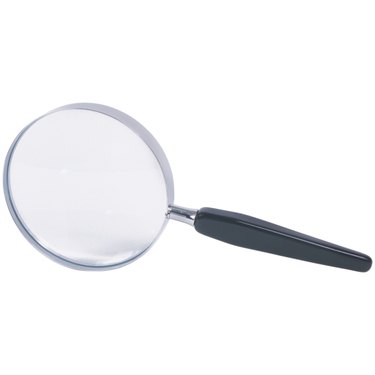
Beads have been used as currency by people all over the world for thousands of years. In its basic meaning, a "trade bead" is simply a bead that has been used for trade. There are a few common types of trade beads you may run into: ancient beads from Egypt, Venetian and Chinese glass beads that were traded heavily by Europeans in Africa and the Americas, and modern beads made by African craftsmen, either from natural or recycled materials.
Step 1
Hold and examine the bead. Try to determine what material it is made of. Glass, stone and metal should feel cold to the touch, while bone, wood and plastic are warmer. A bead that is not made out of glass cannot be a Venetian trade bead. If you can identify specific types of metal or stone, this will also help you narrow down a bead's origins.
Video of the Day
Step 2
Look for signs of how the bead was crafted. If there is a seam, it appears perfectly smooth and symmetrical, or has a hole that is perfectly round, it is likely that the bead was manufactured by modern machinery.
Step 3
Examine the bead for signs of natural aging. Metals change color with age and may be dented or scratched. Glass and stone beads may be cracked or chipped.
Step 4
Consider the style of the bead. If it is a fancy glass bead, compare it against a list of known styles of Venetian glasswork. Venetian glass was traded heavily for centuries all over the world, yet a relatively small number of styles of beads were made by Venetian artisans. Some of the most popular beads were chevrons, usually in red, white and blue; these small cylindrical beads appear striped from the side and reveal a star pattern on the ends. If the bead is simple colored glass, it may be a 19th-century Chinese bead rather than Venetian glass. These were the types of beads that the Lewis and Clark Expedition took to trade with the local tribes along their journey.
Step 5
Familiarize yourself with the different varieties of handmade beads. If the bead is not glass, and appears to be old and hand-crafted, it may be difficult to identify it exactly unless you are an expert. However, if you spend some time learning about the different styles of beads and looking at pictures of them, you will begin to recognize particular styles.
Step 6
Take your bead to an expert for valuation if you believe it is truly old and rare. The subtle differences in color and materials that distinguish a valuable antique trade bead from a bead that is merely old and handmade are usually impossible to identify at home, unless you are an expert.
Tip
"Trade beads" made by modern African craftsmen are less valuable than true antiques, but as genuine handmade crafts, they appeal to many jewelry makers.
Venetian glass beads were traded widely in Africa, the Americas and elsewhere. It does not really matter where a particular bead was traded, except as a historical curiosity; the value of a trade bead depends on its original place of manufacture.
African trade beads are sometimes called "slave beads," as they were a common item of trade for slaves during the era of slavery. This term is a misnomer if applied to modern trade beads.
Warning
Unscrupulous sellers may try to pass off new beads that have been artificially aged as genuine antique trade beads. Never pay premium prices for these beads unless you are sure they are from a reliable source.
Video of the Day